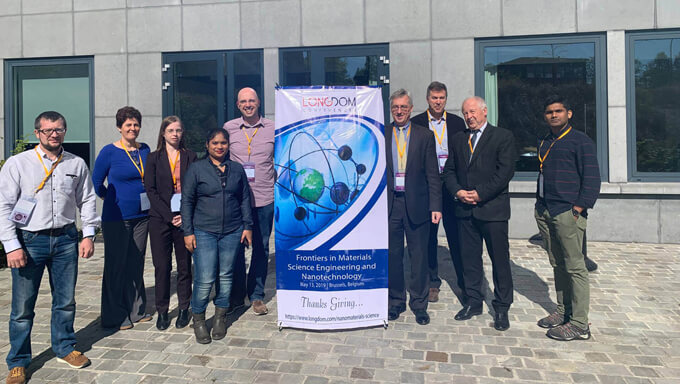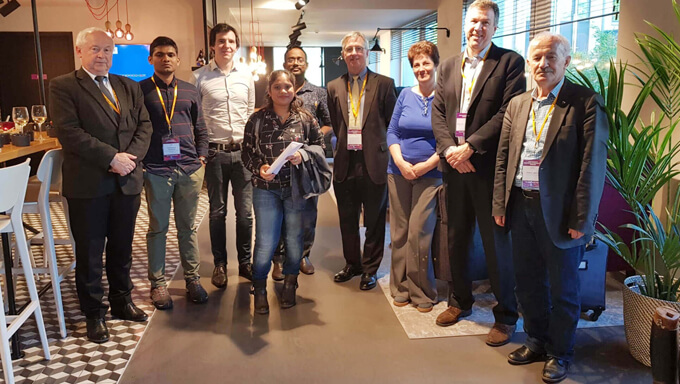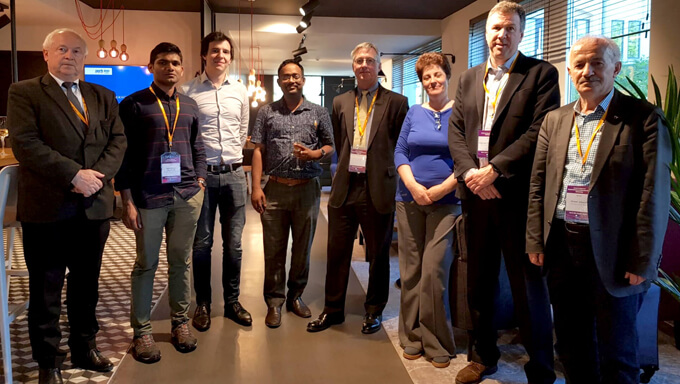







Smart materials also called intelligent or responsive materials, are designed materials that have one or more properties that can be significantly changed in a controlled fashion by external stimuli, such as stress, moisture, electric or magnetic fields, light, temperature, pH, or chemical compounds. Smart materials technology enables us to adapt to environmental changes by activating its functions. Smart materials for active coating transport the sensing and responding properties to textiles by traditional coating technologies. These bio inspired materials can change their dimensions, solubility, color, and shape, etc., upon a specific trigger.
Smart ceramics are the materials fabricated from ultrafine particles. They are hard, brittle, heat-resistant and corrosion-resistant materials made by shaping and then firing an inorganic, non-metallic material, nitride, or carbide material such as clay, at a high temperature. Ceramography is the art and science of preparation, examination, and evaluation of ceramic microstructures. The physical properties of any ceramic substance result’s its crystalline structure and chemical composition. Mechanical properties are important in structural and building materials as well as textile fabrics.
Recently, Nanomaterials have found application in the field of Forensic science with appropriate functionalization techniques. It is possible to develop significantly less-toxic Nanomaterials that have a greater advantage over conventionally used dyes and chemicals for the detection of trace evidence and detection of latent fingerprints, DNA, illicit drugs, fraudulent notes or currencies, chemical and biological warfare agents. Fingerprints are developed from several colored materials such as aluminium flake on a dark background and carbon soot on a light background. However, these materials have major drawbacks such as unclear images of the fingerprint. This problem is solved by using Nanotechnology-based materials.
Smart materials are designed materials that have one or more properties that can be significantly changed in a controlled fashion by external stimuli, such as stress, moisture, electric or magnetic fields, light, temperature, pH or chemical compounds causes transformation of their material property. Good Materials area unit the premise of the many applications along with sensors and actuators, or artificial muscles, significantly as electrically activated polymers.
Over the increasing demand of Sensors, there is a need for development of Smart Materials which can be efficient and safe for various sensing application. Synthesis of these Smart Materials can be conducted through several novel fabrication and characterization techniques. The sensor devices that take information from a physical environment and use embedded microprocessors and wireless communication to monitor, examine, and maintain various systems. They have the ability to collect environmental data more accurately with less erroneous noise. Though they are used for a variety of applications, they are most commonly found in monitoring mechanisms, such as smart grids, science applications, and security systems. Magnetism could be exploited from these innovative Smart Materials especially from graphene.
Biomarkers in basic and clinical research as well as in clinical practice has become so commonplace that their presence as primary endpoints in clinical trials. Biomarkers that have been well characterized and repeatedly shown to correctly predict relevant clinical outcomes across a variety of treatments and populations; this use is entirely justified and appropriate. It is easy to imagine measurable Biological characteristics that do not correspond to patients' clinical state, or whose variations are undetectable and without effect on health. Surrogate endpoints are a small subset of well-characterized Biomarkers with well-evaluated clinical relevance. A Biomarker consistently and accurately predicts a clinical outcome, either a Benefit or harm.
Graphene and related two-dimensional (2D) materials offer prospects of unprecedented advances in device performance at the atomic limit, and a synergistic combination of 2D materials with silicon chips promises a heterogeneous platform to deliver massively enhanced potential based on silicon technology. Integration is achieved via three-dimensional monolithic construction of multifunctional high-rise 2D silicon chips, enabling enhanced performance by exploiting the vertical direction and the functional diversification of the silicon platform for applications in opto-electronics and sensing.
Neuroengineering concentrates on the development of artificial devices and novel materials to be functionally and structurally interfaced with the central nervous system. Today, there is the expectation that materials science and Nanotechnology will be able to address these challenges and conduct to breakthroughs at the level of the interfaces between Artificial transducers/actuators and living cells. Nanoparticles have ability to penetrate the Blood Brain Barrier (BBB) of in vitro and in vivo models; and therefore can be utilized to develop diagnostic tools as well as Nano-enabled delivery systems that can bypass the BBB in order to make conventional and novel Neurotherapeutic interventions such as drug therapy, gene therapy, and tissue regeneration.
Nano medicine is the application of Nano science and its technology in the field of medical science. It ranges from the applications of Nanomaterial’s to Biosensors, also for further upcoming applications of molecular Nanotechnology such as biological machines. Most of the biological structures are equal to the size of the Nanomaterial. So the functionalities of those structures can be quickly replaced by means of adding the specific functionality to Nanoparticles.
Optical and Electronic Smart Materials are connected and related with light and electricity. Optical and Electronic materials comprise the study, design, and manufacturing of smart materials that can convert electrical signals to light signals and light signals to electrical signals. The devices which convert them is called Optoelectronic devices. Optoelectronics escalates in the quantum mechanical effect of light. These Optoelectronic technologies consist of laser system, remote sensing systems, fiber communications, and electric eyes medical diagnostic systems.
Nanotechnology, a promising field of research welcomes in the present decade a wide array of opportunities in the present decade and is expected to give major impulses to technical innovations in a variety of industrial sectors in the future. The potential advantages and benefits of Nanotechnology are enormous. These include agricultural productivity enhancement involves Nanoporous zeolites for slow release and efficient dosage of water and fertilizer, Nanocapsules for herbicide delivery and vector and pest management and Nanosensors for pest detection. The atom by atom arrangement permits the manipulation of Nanoparticles thus influencing their size, shape and orientation for reaction with the targeted tissues. It is now known that many insects have ferromagnetic materials in the head, thorax and abdomen, which act as geomagnetic sensors.
New energy efficient technology based on Smart Materials fast developing and becomes increasingly cost-effective, with much shorter payback periods. Investing in renovation of existing building stock using Energy-Saving Technologies, such as innovative Smart Materials, offer an opportunity for housing energy efficiency. Smart Materials are undertaken only on a limited scale; because of lack of knowledge about their changeable properties and dynamism in that they behave in response to energy fields. Technological chain involved in the design, production and implementation of Smart Materials in refurbishment of existing buildings could allow the energy performance of buildings to influence their value. Distributive electricity and heating networks also experience less load intensity due to Smart Materials, that making better indoor conditions by reducing building‘s exposure to the fluctuation of outdoor conditions.
It refers to the importance of Nanotechnology to develop the environmental sustainability of processes that are producing negative externalities. For the base of sustainability, they are making Green Nano-products and using Nano-products. The main aim of this technique is to minimize harmful environmental hazards and human health risks associated with the manufacture of Nanotechnology products, and also to boost replacement of existing products with new Nano-products that should be eco-friendly to the people. Nanomaterials or Nanoproducts used under this technology can perform several functions.
We let our ground-breaking work and our amazing clients speak for us…… LONGDOM conferences